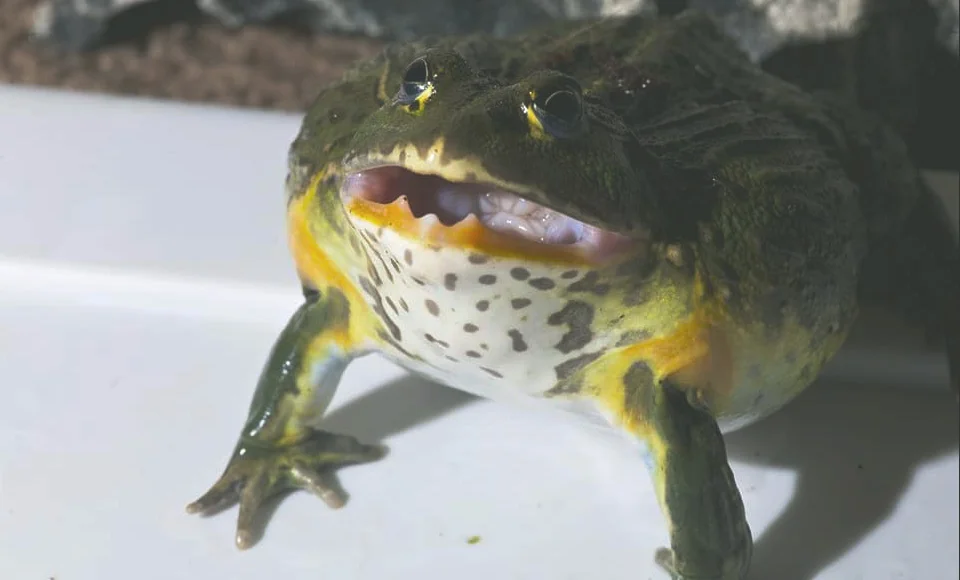When we hear the term “bullfrog,” an image of a robust amphibian often springs to mind. Yet, this term encompasses a variety of species, with the American and African bullfrogs being the most familiar. Inhabitants of freshwater havens like lakes, ponds, and marshes worldwide, bullfrogs captivate us not only due to their size but also their diverse diet, encompassing rodents, reptiles, birds, and even fish. A question arises: Considering their diet, do bullfrogs have teeth that match their voracious appetites? The surprising answer unravels a tale of unique dental adaptations that set them apart from the norm.
Do Bullfrogs Have Teeth?
At first thought, carnivorous tendencies would lead one to expect sharp, menacing teeth in bullfrogs. However, reality takes a different course. Bullfrogs stand apart from the conventional dental structures observed in most animals, including humans. Typically, teeth are composed of robust materials like enamel, dentin, and cementum, firmly rooted within the jawbone. Bullfrog teeth, on the contrary, defy expectations. They possess two distinct types of teeth, maxillary and vomerine teeth, each designed for a unique purpose.
Unlike the commonly known African Bullfrog, which showcases an anomaly, most bullfrogs undergo a continuous cycle of tooth replacement. Shedding a tooth is no concern, for a replacement tooth is always at the ready, a phenomenon that persists throughout their lives.
Maxillary Teeth: A Closer Look
Maxillary teeth, residing on the upper jaw, might be elusive to the observer due to their minute size. Even when gaping wide, these teeth remain inconspicuous. Diverging from the diverse shapes and sizes that characterize teeth in various species, bullfrogs sport uniformly conical maxillary teeth. Positioned in a circular array along the outer rim of the upper jaw, these tiny teeth play an unexpected role.
Contrary to their size, maxillary teeth aren’t tasked with mastication. Instead, their purpose lies in aiding the manipulation of prey within the mouth, ensuring it stays steady during the swallowing process. Here, the unique feeding mechanism of frogs comes into play—using their tongues, they seize the prey and guide it into their mouths, skipping the act of chewing altogether.
Vomerine Teeth: The Hidden Artillery
While maxillary teeth are subtle, vomerine teeth take subtlety to another level. Concealed partially beneath a mucous membrane, they are formidable to spot. The name “vomerine teeth” originates from their location on the vomer bone within the skull, a component of the nasal region. Inhabitants of the mouth’s roof, these teeth manifest as sharp, pointed structures, typically arranged in pairs. Yet, their purpose diverges from conventional assumptions.
Vomerine teeth do not contribute to the grinding process as expected. Instead, they serve a critical role in facilitating the swallowing of prey. These minute, pointed teeth engage with the prey, preventing its escape and ensuring a swift transition to the digestive journey.
Ancient Echoes And Modern Wonders
The captivating realm of bullfrog teeth doesn’t just end with their contemporary species. Delving into the past reveals prehistoric frogs with equally captivating dental adaptations. The enigmatic Beelzebufo ampinga, an extinct frog species from Madagascar, boasted impressive oral structures resembling tusks rather than conventional teeth. These structures were likely used for combat or intimidating displays, showcasing the diverse evolutionary trajectories frogs have taken.
In Conclusion: Do Bullfrogs Have Teeth?
In the grand tapestry of nature’s wonders, bullfrog teeth emerge as a fascinating chapter. Contrary to assumptions fueled by their carnivorous tendencies, these amphibians sport teeth designed for manipulation rather than mastication. The intricate interplay of maxillary and vomerine teeth underscores the adaptability of these creatures in their quest for sustenance. Their unique feeding mechanisms, bypassing chewing in favor of swift swallowing, highlight the
ingenious ways in which nature crafts solutions to survival challenges.
So, the next time you ponder, “Do bullfrogs have teeth?” Remember that the answer transcends mere dental structures; it unravels an enthralling tale of adaptation and innovation, reminding us once again of the endless marvels that inhabit our world.



